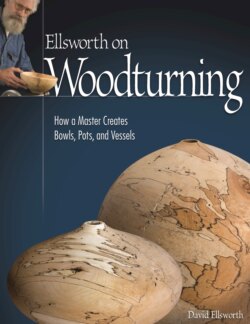Читать книгу Ellsworth on Woodturning - David Ellsworth - Страница 19
На сайте Литреса книга снята с продажи.
Dissecting the burl
ОглавлениеThe wonderfully rounded mushroom-cap shape of the broadleaf maple burl pictured at top right demanded me making one single hollow form. Trimming the excess with plunge cuts produced a circular form 19" in diameter, just the right size to clear the bed on my 20"-capacity lathe.
When dissecting a burl, I will often circle all the primary nodules with the tip of the chainsaw, then start working in from the burl's end, where I can cut trunk sections away without damaging the burl areas I wish to use. I then work my way through the log, undercutting each lump and extracting them one at a time. This type of cutting requires numerous plunge cuts between each lump. These are dangerous cuts unless you have plenty of training and experience, but this is the only way to properly work through the burl without wasting material.
After plunge cutting with the chainsaw, I’ve created a reasonably round blank to turn. Sometimes, the designs inside a burl will jump out at you.
I don’t recommend this type of activity when dissecting a burl with a chainsaw, so if you don’t want to look, don’t look. The chunk I am working on is about a quarter of the original redwood lace burl.
A Norway maple burl partially dissected. The shape of the tree burls were set up ideally to make nine or ten finished pieces.
